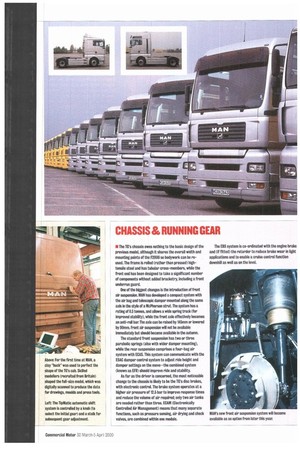CHASSIS & RUNNING GEAR
Page 19

If you've noticed an error in this article please click here to report it so we can fix it.
• The TG's chassis owes nothing to the basic design of the previous model, although it shares the overall width and mounting points of the F2000 so bodywork can be reused. The frame is rolled (rather than pressed) hightensile steel and has tubular cross-members, while the front end has been designed to take a significant number of components without added bracket ry. including a front underrun guard.
One of the biggest changes is the introduction of front air suspension. MAN has developed a compact system with the air bag and telescopic damper mounted along the same axis in the style of a McPherson strut. The system has a rating of 8.5 tonnes, and allows a wide spring track (for improved stability), while the front axle effectively becomes an anti-roll bar The axle can be raised by 145mm or lowered by 90mm. Front air suspension will not be available immediately but should become available in the autumn.
The standard front suspension has two or three parabolic springs (also with wider damper mounting). while the rear suspension comprises a four-bag air system with ECAS. This system can communicate with the ESAC damper control system to adjust ride height and damper settings on the move—the combined system (known as EFR) should improve ride and stability.
As far as the driver is concerned, the most noticeable change to the chassis is likely to be the TG's disc brakes, with electronic control. The brake system operates at a higher air pressure of 12.5 bar to improve response times and reduce the volume of air required; only two air tanks are needed rather than three. ECAM (Electronically Controlled Air Management) means that many separate functions, such as pressure sensing, air drying and check valves, are combined within one module. The EBS system is co-ordinated with the engine brake and (if fitted) the retarder to reduce brake wear in light applications and to enable a cruise control function downhill as well as on the level.
















































































































